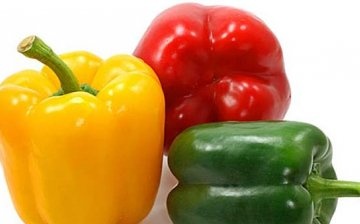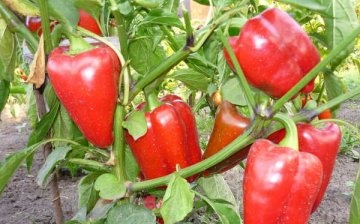Planting pepper seedlings in a greenhouse and open ground
Bell pepper is a rather demanding culture in terms of growing conditions. To get a good harvest, it is equally important to grow good seedlings and follow the correct agricultural techniques.
Content:
- Growing seedlings
- Soil preparation and planting pepper seedlings
- Agricultural technology of cultivation
- Beneficial features
Growing seedlings
In the middle latitudes, pepper is grown using seedlings, it has such a long ripening period that otherwise you will not get a harvest. On the other hand, this plant does not tolerate transplanting very well, so it is advisable to sow it not in a common box, but in separate containers, from where the seedling is subsequently transferred along with a lump of earth to a permanent place. Before sowing, the seeds are soaked in a solution of sodium chloride to separate the pacifiers (those that float). The remaining seeds are wrapped in a damp cloth close to the heat source. After about a day, they will germinate, after which they are planted in moist soil.
It is best to choose varieties that are zoned in the area where you live and sow about two months before planting in the ground or greenhouse, taking into account the fact that the seeds germinate within 10-15 days. Each container with a plant should be covered with glass or polyethylene, turning it into a mini-greenhouse and placed in a warm place. Often, seedlings do not appear after these manipulations, so you should initially sow more seeds than seedlings are needed, the remaining containers with soil can then be used when picking tomato or flower seedlings. Pepper seedlings should be fed with diluted bird droppings or mineral fertilizers every 10 days. Fully finished seedlings should have up to 14 true leaves and flower buds, and sometimes ready-made ovaries.
Soil preparation and planting pepper seedlings
In open soil, it makes sense to grow sweet peppers only in the southern regions, in the middle lane and Siberia, it will not die either, but, you must admit, it will be a shame to collect one vegetable from each bush, so it is better to prepare a greenhouse with fertile soil and good drainage. For digging, humus and mineral fertilizers that do not contain chlorine are introduced into it. Immediately before planting, holes are made so that the seedlings can be buried to the height of the pot. The distance between the bushes should be at least 40 cm. Usually, a staggered planting in two rows is used, the distance between the rows is about half a meter. It is important that the earth is well warmed up, up to about +15 degrees. To avoid cross-pollination, sweet and hot peppers should not be less than two meters apart.
Agricultural technology of cultivation
Pepper care includes watering with exceptionally warm water, followed by airing the greenhouse, weeding, fertilizing and loosening the soil. Pepper is a plant that is very responsive to feeding. The first time it is carried out two weeks after planting with the help of a mullein and superphosphate. Then, every 10 days, the vegetable is fertilized with ash or other potash fertilizer without chorus. The bush is formed into 3-4 stems, if necessary, tall varieties are tied up.
To repel pests, marigolds or basil can be planted in the aisles. and to lure pollinating insects, lay out banana skins and apple pieces.The fruits that have ripened to technical ripeness are removed, they ripen perfectly indoors, and the plant will have more strength to set and grow new peppers. Such is the amazing paradox: the more often you harvest, the more abundant it will be. In the fall, good bushes can be transplanted into a pot and put on a window in an apartment or house, all winter they will delight you with fresh fruits.
Beneficial features
Sweet pepper has excellent taste and therefore has become the favorite crop of many gardeners. In addition, it has a number of useful properties due to its chemical and biological composition. It is downright the champion among vegetables in terms of vitamin C content, in the fruits of this plant it is even more than in black currant and lemon. There are other vitamins in this vegetable, for example, A, B1, B2, P, pyridoxine, folic acid. Bell peppers are also rich in minerals, they contain calcium, iodine, iron, zinc.
The characteristic taste of this vegetable is given by the alkaloid capsaicin contained in it. Thanks to this substance, the consumption of pepper improves digestion, helps to thin the blood and lower blood pressure. In addition, bell pepper is useful for vitamin deficiency, insomnia, vascular problems, iron deficiency anemia, chronic fatigue, and diabetes mellitus. It contains chlorogenic acid, which binds and removes carcinogens from the body.










